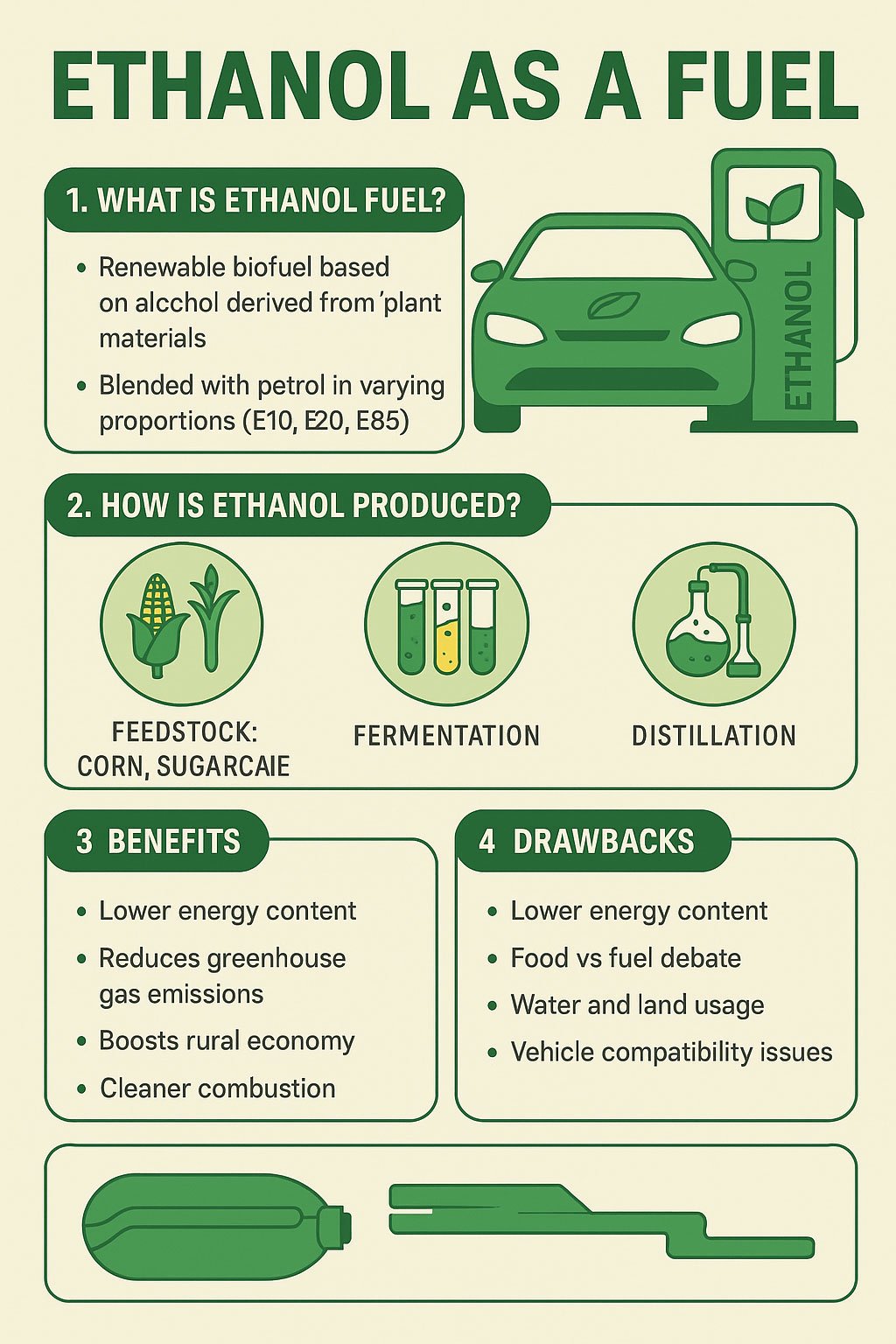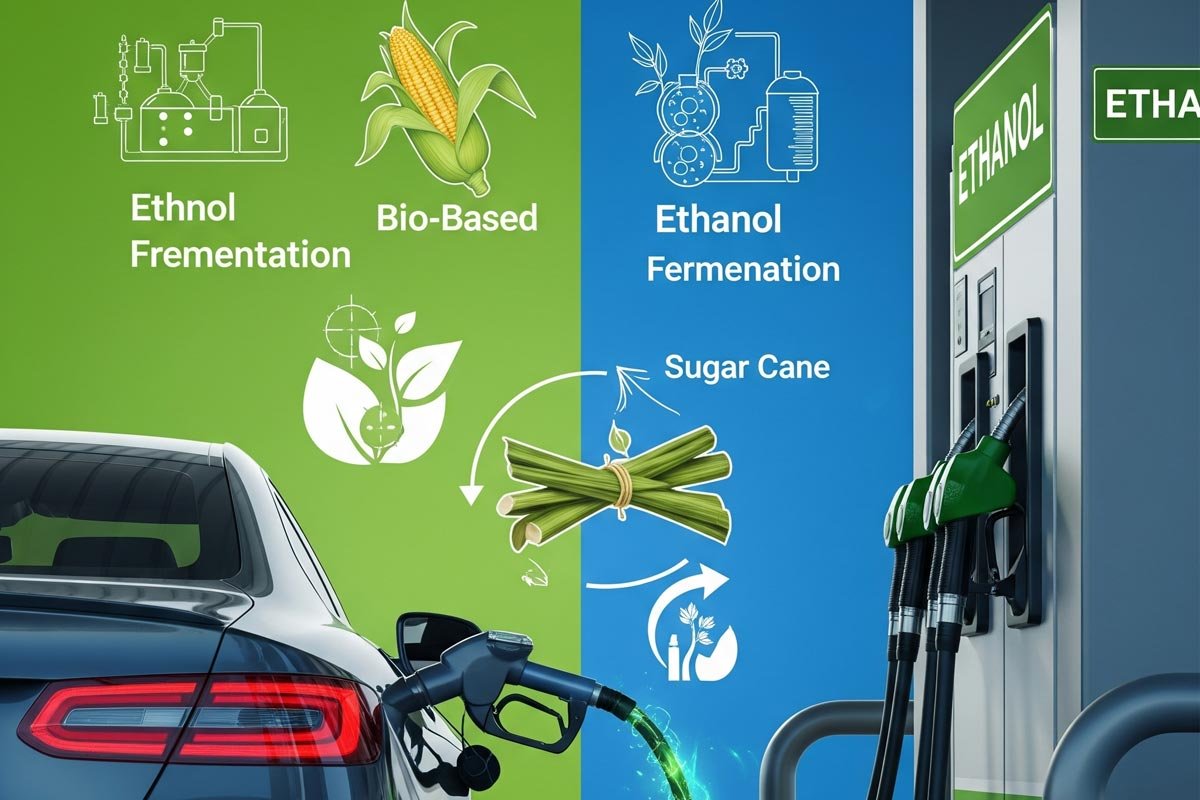As the global community grapples with climate change, urban air pollution, and energy security concerns, the spotlight is shifting increasingly to alternative fuels. One such fuel is ethanol – a renewable, agriculturally derived alcohol that has gained prominence as a cleaner-burning fuel for internal combustion engines. Ethanol isn’t just a fuel; it’s a symbol of how agricultural innovation, energy policy, and automotive technology can intersect to reshape the transportation landscape. In this article, we will explore what ethanol fuel is, how it is produced, and its benefits and drawbacks.
1. What is Ethanol Fuel?
Ethanol is a bio-alcohol (chemical formula: C₂H₅OH), traditionally used in alcoholic beverages, but now produced at an industrial scale as a transportation fuel. In the automotive context, ethanol is either used on its own or blended with petrol (gasoline) in various ratios:
- E10: 10% ethanol + 90% petrol
- E20: 20% ethanol + 80% petrol
- E85: 85% ethanol + 15% petrol (for flex-fuel vehicles)
- E100: 100% ethanol (used mainly in Brazil)
Ethanol is oxygenated, meaning it contains oxygen in its molecular structure, which helps in the more complete combustion of fuel in engines. This leads to lower tailpipe emissions of carbon monoxide, hydrocarbons, and particulate matter.
2. How is Ethanol Produced?
The production of ethanol varies based on region, crop availability, and technological infrastructure. Let’s examine how it is produced both globally and in India.
2.1 Global Production
Globally, ethanol is produced through the fermentation of sugars and starches present in crops. The process typically involves the following steps:
- Feedstock Collection:
- In the U.S., the primary feedstock is corn.
- In Brazil, it is sugarcane.
- In the EU, it includes wheat, sugar beet, and other grains.
- Processing and Fermentation:
- The starch or sugar is extracted and broken down by enzymes and yeast into simple sugars (glucose/fructose).
- These sugars are fermented into ethanol and carbon dioxide.
- Distillation:
- Ethanol is then separated from the mixture via distillation, usually achieving about 95–96% purity.
- It is further dehydrated to produce anhydrous ethanol (99.5%) suitable for fuel blending.
- By-products:
- In the U.S., Distillers Dried Grains with Solubles (DDGS) are produced, which are high-protein animal feed.
- In Brazil, leftover bagasse from sugarcane is used to generate electricity, making ethanol production energy-positive.
2.2 Ethanol Production in India
India’s ethanol production is strategically aligned with its sugar economy and surplus grain management. Here’s a breakdown:
- Primary Feedstock:
- Sugarcane Molasses: A by-product of sugar manufacturing; most ethanol in India comes from this source.
- Sugarcane Juice: Direct fermentation is allowed under the new biofuel policy.
- Surplus and Damaged Food Grains: Maize, broken rice, wheat unfit for human consumption.
- Emerging Technologies:
- 2nd Generation (2G) Ethanol from agricultural waste like rice straw, corn stover, wheat husk, etc., is being explored to address the food-vs-fuel debate.
- Government Initiatives:
- The Ethanol Blending Program (EBP) targets 20% ethanol blending by 2025, up from around 11.8% in 2023.
- Oil PSUs like IOCL, HPCL, and BPCL are building advanced bio-refineries to produce ethanol from lignocellulosic biomass.
3. Benefits of Using Ethanol as a Fuel
3.1 Renewable and Locally Available
Unlike fossil fuels, which are finite and geopolitically sensitive, ethanol is produced from renewable biological sources. Countries like India and Brazil can leverage their large agricultural base to produce ethanol domestically, reducing reliance on imported crude oil and enhancing energy sovereignty.
3.2 Reduces Carbon Emissions
The environmental argument in favour of ethanol is strong. When combusted, ethanol releases less CO₂ compared to petrol. Even though ethanol emits CO₂ during combustion, this is largely offset by the carbon absorbed by the feedstock plants during their growth phase. As a result, ethanol can cut lifecycle greenhouse gas emissions by 20–70%, depending on the source.
3.3 Supports the Rural Economy
The ethanol industry can be a massive economic multiplier for rural areas. It provides farmers with additional markets for their crops and offers employment in processing, logistics, and bio-refinery operations. In India, ethanol production is expected to add tens of thousands of crores to the rural economy.
3.4 Improved Engine Efficiency and Cleaner Combustion
Ethanol has a higher octane rating than petrol, which allows for more efficient engine tuning and better performance in turbocharged engines. Its oxygen content also results in lower emissions of CO, NOx, and particulate matter, contributing to improved air quality in urban areas.
4. Drawbacks and Challenges
4.1 Lower Calorific Value
One major disadvantage of ethanol is its lower energy density. Ethanol contains about 33% less energy per litre than petrol, meaning vehicles may experience a drop in fuel economy, especially at higher blend ratios like E85 or E100.
4.2 Food vs Fuel Debate
Using food crops such as corn, sugarcane, or grains for ethanol has raised ethical concerns, particularly in countries with large populations below the poverty line. There’s a risk that increasing ethanol demand could drive up food prices and impact food security.
4.3 Water Intensity and Land Use
Ethanol production is water-intensive, both for growing feedstock and for processing. For example, sugarcane cultivation uses over 2,500 litres of water per kg. Expanding ethanol production can strain already stressed water tables and arable land.
4.4 Engine Compatibility and Fuel Infrastructure
Traditional petrol vehicles may not be compatible with higher ethanol blends like E20 or E85 without engine recalibration, fuel line upgrades, and corrosion-resistant materials. Moreover, ethanol’s hygroscopic nature (it absorbs water) can cause storage and fuel system corrosion if not managed properly.
5. The Future of Ethanol
5.1 Global Trends
Globally, ethanol is evolving beyond simple crop-based production:
- Second-generation ethanol from agricultural residues is gaining traction. It bypasses the food-fuel conflict while tapping into abundant waste biomass.
- Countries like Brazil and the U.S. are leading the deployment of flex-fuel vehicles, capable of running on a range of ethanol-petrol blends up to E100.
- The EU is promoting advanced biofuels and setting mandates for reducing the carbon intensity of transport fuels.
5.2 The Indian Roadmap
India’s ethanol story is gathering pace:
- The government has advanced the E20 target to 2025, and many manufacturers (like Maruti, Hero, and TVS) are testing and releasing E20-compliant engines.
- Flex-fuel vehicles are expected to enter the Indian market, especially for two-wheelers and small cars.
- 2G Ethanol Projects: Public and private sector companies are investing in projects that turn agricultural waste into ethanol, which can both manage crop stubble and produce fuel.
- Policy Ecosystem: The National Bioenergy Programme, GST reduction on biofuels, and financial incentives are pushing the industry forward.
6. Conclusion
Ethanol is not a one-size-fits-all solution, but it plays a crucial transitional role in making transport cleaner and more sustainable, particularly in countries with strong agricultural bases like India and Brazil. It helps diversify the energy mix, reduce carbon emissions, and promote rural development.
However, challenges around water usage, food security, infrastructure, and engine compatibility must be addressed through technology innovation, regulation, and education.
In the long-term energy landscape, ethanol will likely co-exist with electric and hydrogen vehicles, forming part of a multi-pronged strategy to decarbonise transport without sacrificing affordability or accessibility.




